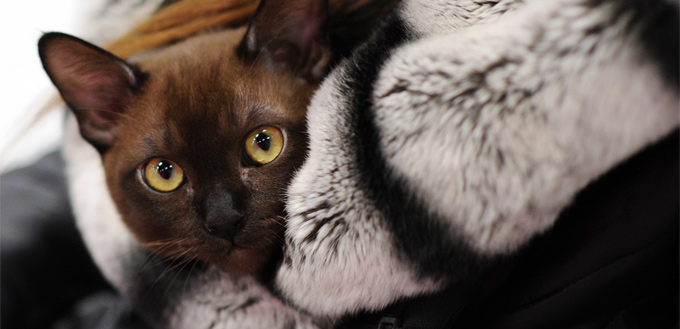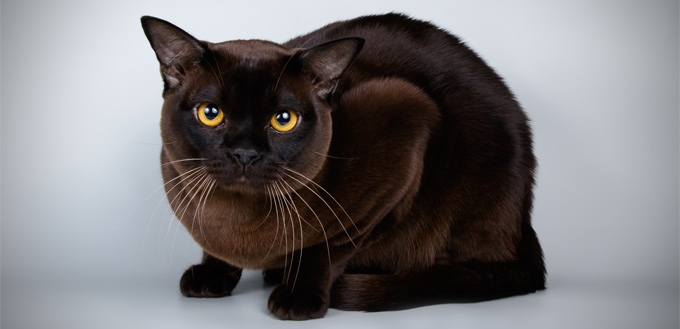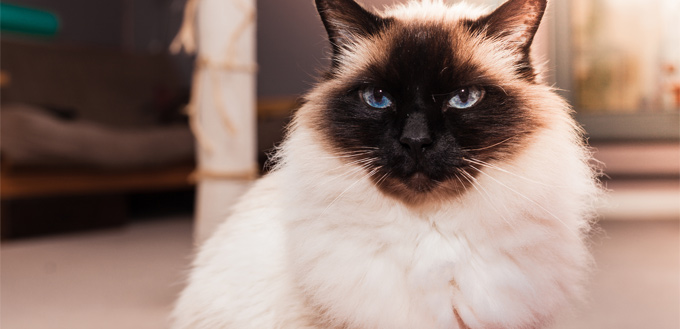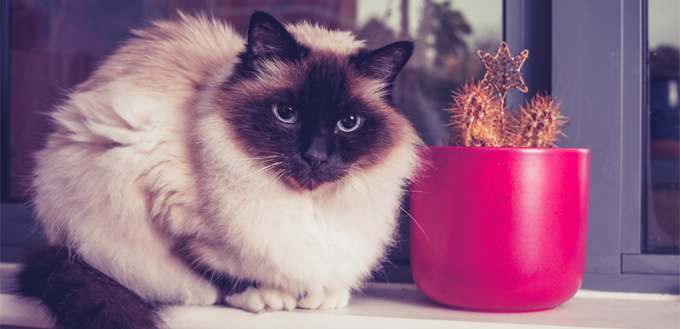History of the Birman Cat
There aren’t many written historical records about the origins of the Birman cat. However, a beautiful feline such as this deserves only the most beautiful legend as to its origins. Cats have always been held in the highest esteem by the Ancient Egyptians, with the ancient peoples worshipping Bastet, the Cat Goddess. But if one thinks that only the ancient Egyptians revered their cats, you’d clearly be mistaken.
While the Birman is no Cat goddess, there is a legend in Burma that tells of the tale of an unassuming temple cat whose unquestionable devotion and unfathomable love for its priest drew the attention and admiration of a blue-eyed goddess (it is believed that this goddess is an important figure in Burmese mythology.
These temple cats had yellow eyes and white elegant-looking, long hair. They are revered as the guardians or protectors of the Temple of Lao Tsun. The temple worshipped the golden goddess, Tsun-Kyan-Kse who had deep blue eyes. One of the temple cats, Sinh, was the companion of the temple’s head priest, Mun-Ha.
When the temple was attacked, Mun-Ha was killed. Upon Mun-Ha’s death, Sinh sat beside its master’s lifeless body and placed its paws on its master. As soon as Sinh placed its paws on Mun-Ha’s body, its white coat turned into a golden hue while its yellowish eyes took on the deep blue eyes of Tsun-Kyan-Kse. Sinh’s face, tail, and limbs took on a more brownish hue to depict the color of the Earth. Its paws, still resting on the body of Sinh’s master, remained white. The other temple cats also changed in their appearance. Sinh died 7 days later and legend has it that Sinh took Mun-Ha’s soul to paradise.

The legend has been passed on across generations of temple priests and local Burmese alike. It is said that these temple cats – the sacred cat of Burma – are the epitome of an animal’s undying loyalty, devotion, and affection to its human master.
This is a myth, of course, and one that very few in the Western world would want to believe in. So, when it comes to the more ‘logical’ or ‘historical’ origins of the Birman, your guess is as good as anybody else’s.
There are also stories about the Birman cat having been developed in France. The story speaks of a pair of Frenchmen having brought the cats to France in 1919 as gifts or rewards for their assistance given to the temple priests in Burma. As to what they specifically did that merit the rewarding of temple cats by the priests, nobody knows. Some say the duo helped defend the temple.
And then there’s the story where a pair of temple cats were clandestinely shipped to France. The male temple cat perished on the voyage, but not before having impregnated the female temple cat, named Sita. The mommy feline delivered its kittens and they provided the basis for the breeding of the Birman cat in Europe.
There’s also the version of the temple cats being stolen by a disloyal Temple of Lao Tsun servant and given to a Vanderbilt, an American millionaire traveling in the Far East at the time. Vanderbilt gave the cats to Madame Thadde Hadisch who brought the pair to Nice, France in 1920. Unfortunately, the male temple cat also perished on the voyage, but the female survived and was impregnated by the male prior to its demise. One of the kittens was considered more elegant than the rest and was named Poupee.
It was impossible to breed Poupee with another temple cat since there weren’t any. As such, Poupee was mated to a Laotian Lynx. The resulting kittens looked a lot like Siamese cats. Successive breeding finally resulted in a female cat that closely resembled Poupee. They named it Manou de Madalpour. Manou was mated to a Siamese cat.
There’s one problem, though. Marcel Reney wanted to get to the bottom of the mystery. As it turns out, there was no such person as Mme Hadisch and that the so-called Laotian Lynx cannot really be distinguished from the Siamese cat. Reney’s investigation also revealed that Mme. Mercelle Adams, the owner of Manou de Madalpour, did not know of any Mme Hadisch.
Could it be that there is more to the legend of the sacred cat of Burma? The mystery deepens.
The only credible account as to the origins of the Birman is the writings of the Frenchman Auguste Pavie and Sir Gordon Russell who aided the priests of the Temple of Lao Tsun in their defense against invasion and intrusion.
Regardless, in 1925, the French Cat Registry officially recognized and registered the breed as “Sacre de Birmanie”, hence the name Birman Cat.
The Second World War took its toll on the Birman as only a pair was left after the war – Orloff and Xenia de Kaabaa – owned by Baudoin-Crevoisier. The pair produced 5 kittens named Manou, Sita 1, Sita 2, Djaipour, and Lon saito. These Birmans had to be outcrossed with other breeds of cats especially the long-haired ones. By the middle of the 20th century, Birman purebreds are being produced again. In 1965, the UK recognized the Birman as a breed. The Cat Fanciers Association followed suit in 1966.
The Birman reached the shores of the US in 1959. The breed currently ranks as CFA’s number 9 cat and is continuously used to crossbreed with other breeds.
Quick Facts About the Birman Cat
While the origins of the Birman Cat remain a mystery, whether you believe in legends or more with real-life stories of deceit, it is one of the most-loved cats in the pet kingdom. Aside from its unique looks, it is also revered for its loving and calm personality. Other facts about the breed are as follows:
- A fully-grown Birman can weigh at least 6 pounds, but never heavier than 12 pounds.
- It can have a lifespan reaching 16 years, with the minimum set at 12.
- Its body is almost rectangular in shape and comes with a rather broad face plus a highly-distinct Roman nose.
- It is medium-sized and its ears should be set on top of its head. The width of the base of the ears should also be the same with the height of the ears.
- One of the characteristics of the Birman is a pair of deep sapphire blue, rounded eyes.
- All four feet of the Birman should be white and should come with a ‘gloves and laces’ pattern.
- They have an angel-like voice, often with a very sweet and soft meow.
- It looks a lot like the Siamese cat.
- Despite its fluffy fur, the Birman doesn’t have a double coat. Instead, it sports a full remarkably silky topcoat. Best of all, it never tangles or matts.
- It is one of the breeds of cats that are considered hypoallergenic or less-shedding.
- The coat can come in different colors but it is always in color points. You can have blue, lilac, blue cream, chocolate, seal tortie, chocolate tortie, cream, and lilac tortie.
- Having been the companion of temple priests, the Birman isn’t your typical cat that can live in solitude. It longs for the companionship of its human master, pretty much like a dog. That being said, it’s also prone to separation anxiety and depression if left alone for a long period. Perhaps there’s truth to the Birman legend of Sinh.
- The Birman is one of the healthiest breeds of cats in the world.

Things You Should Know
Known for its affection and devotion to its family, the Birman Cat is one of the most sought-after felines in the cat-loving community. Its point color scheme plus deep sapphire blue eyes are often enough to make this cat a true standout anywhere it goes. It wouldn’t really surprise us if you’re going to bring one home. It would greatly disappoint us if you wouldn’t.
Health
The modern Birman has some of the genetic traits of the Siamese cat because of the intensive re-breeding program after the Second World War. Surprisingly, the Birman doesn’t have any of the health conditions that plague Siamese cats like breast cancer, eye disorders, upper respiratory tract infections, hydrocephalus, and even mental and behavioral disorders.
The Birman Cat is regarded as one of the feline kingdom’s sturdiest, most robust, and healthiest breeds. Is it possible that it is still protected by Tsun-Kyan-Kse or even by the spirit of Mun-Ha? Whatever the case, its health has always considered an advantage for pet parents as they no longer have to worry so much about expensive veterinary care.
However, just because the Birman is a sturdy cat doesn’t mean you can already skimp on your search for the best. When buying or getting a Birman from a breeder or from any other person, it is imperative that you seek information about the Birman’s parents and grandparents. There are certain hereditary diseases that somehow ‘skip’ a generation. So the disease may not be present in the parents but are present in the Birman’s grandparents. As such, the next plausible presentation of the disease will be on the current generation.
This is especially true for feline hypertrophic cardiomyopathy, an autosomal dominant trait that can be inherited from one or both of the parents. This can lead to paralysis of the cat’s rear limbs, heart failure, and death.
Alternatively, getting a feline DNA test can help establish whether your Birman has genetic markers for diseases.
Some of the more common diseases that may be present in a Birman, although quite rare, include congenital hypotrichosis, corneal dermoid, and spongiform degeneration.
In congenital hypotrichosis, the Birman kitten is born with no hair and its thymus is not fully developed which can lead to a compromised immune system. This leads to massive infections resulting in the demise of the kitten.
Birmans with spongiform degeneration is often seen limping especially in their hind legs. They also sometimes present with highly-uncoordinated movement. The condition affects the motor component of the feline nervous system.
Corneal dermoid is another very rare disease of the Birman whereby skin and hair are present on the surface of the cat’s cornea. The good news is that this condition can be surgically corrected.
Other very rare conditions that can affect a Birman Cat can include idiopathic trembling or shaking in kittens between the ages of 10 days and 12 weeks and unusually high concentrations of creatinine or urea in the cat’s blood.

Feeding
The Birman Cat, like most other felines, thrives well on raw food since it is the closest thing they can have to what they have been consuming in the wild. Unfortunately, it’s not always possible to follow the strict requirements of going raw or even in the making of homemade cat food. As crazy as it may sound, your best choice for a Birman Cat diet is commercially-available cat food.
However, it is imperative to give cat food that contains higher quality animal proteins. Again, no offense to our vegan and strict vegetarian pet parents, but felines are obligate carnivores. And while one may think that a plant protein is the same as an animal protein for the simple logic that both are ‘proteins’, this is a serious oversight. Plant proteins lack certain essential amino acids needed by cats, but most especially taurine. This amino acid is important in the normal development of a kitten’s brain, heart, retina, and platelets.
You can still choose a cat food that contains plant proteins, why not. But the plant proteins should never be the first ingredient in the formulation; that spot should always be reserved for a high-quality animal protein.
Moreover, this is where the quality of the protein becomes very important. Under no circumstance should you give the Birman cat food that contains meat or poultry byproducts as these do not contain sufficient amounts of high-quality protein. They do contain minerals and other substances, though. As such, you can always give the Birman Cat pet food that has meals from a named animal protein. For instance, give it ‘chicken meal’ instead of ‘poultry meal’. Why? Well, there are so many animals that can be classified as ‘poultry’. Do you know which kind is used in a ‘poultry’ meal?
You can still give carbs to your Birman cat, but it should never comprise more than 50% of its macronutrient food composition. Proteins should always take precedence over carbs especially since you’re talking about a cat that is not as physically active as a dog. Giving it too many carbs without increasing its activity levels can predispose the Birman to feline obesity. Instead of having a legendary Burmese cat, you’ll end up with just another Garfield in your home.
Most pet parents of Birmans prefer wet or canned cat food since it’s more palatable and provides the moisture that they need. Birmans are not that different from other kitties that have very low thirst drive. Most of their water needs come from their food, although you can always train your Birman to drink from its water bowl or a dedicated cat water fountain. In such cases, dry cat food can be considered.
If your Birman has heart disease, it is often necessary to make changes to its diet, especially the amount of salt consumed every day. The level of sodium restriction is commensurate to the severity of heart disease. The more severe it is the greater is the salt restriction.
A 3-month old Birman kitten can be fed 3 times a day while a 6-month old kitten can be fed twice a day. This feeding schedule can continue for the rest of its life.
Care
Caring for the Birman Cat is relatively easy. It has a rather thick coat, yes; but, this doesn’t mean you will have to brush it every day. This is rather surprising since Birmans do have longer fur, yet they shed less often and do not mat or tangle. Once weekly brushing is often enough to maintain the silky softness of their fur. Expect the Birman to shed in the springtime, however; so it is best to increase the frequency of brushing during this time of the year. You can also give your Birman a bath just so you can maintain the health of both its fur and its skin.
Dental hygiene is always a must. Trimming or clipping the nails can be done once or twice a month. The corners of the Birman’s eyes should also be wiped using a soft, moist cloth to help remove any eye discharge that can stain the fur around the eyes if not removed. The ears need to be checked weekly and cleaned if dirty. Always use a cat-appropriate ear cleanser and avoid using Q-tips or cotton swabs as these can damage the inside of the Birman’s ear.
The litter box should be regularly cleaned and the cat litter replaced. The Birman is like any other feline that is very conscious about bathroom hygiene. If it sees or senses that the litter box is not ‘clean’, it won’t hesitate to bring its business elsewhere.
Keep the Birman indoors to keep it safe. This is a highly-prized breed of cat. You don’t know just how many individuals want to have a Birman for their own. Plus, the outdoors may not be the safest for your pet especially if it interacts with other cats with highly-contagious diseases. The risk of accidents and injuries is also greater outdoors than indoors.
Related Post: Best Cat Ear Cleaner
Grooming
Weekly brushing of the coat is a must for the Birman Cat. This is despite the fact that its coat is tangle- and mat-free. You still want to make sure it retains that silky-smooth flow of its long hair, a characteristic that is well-appreciated by those who see the Birman.
Bathing the Birman is optional, although it would be nice to do it every 3 months. Alternatively, you can get one of those pet wipes that you can use on your Birman’s body to give it an instant bath sans the water and cat shampoo.
The rest is routine grooming requirements: inspecting and cleaning the ears, clipping and filing the nails, and brushing the teeth. Cleaning the corners of the eyes should also be done as needed.

Related Post: Best Cat Nail Clippers
Temperament
Definitely more physically active than a Persian cat and less nervous than a Siamese, the Birman Cat is a mild-mannered, gentle, affectionate, and people-oriented feline. It does well in the company of its human family and very tolerant with kids. They can also live peacefully and harmoniously with other pets, provided the other pets are also socialized in the presence of the Birman.
It is intelligent and very adaptable. It can be trained to perform some tricks if its pet parent knows how to. It is very inquisitive and loves to roam around the house rather than stay in just one place all day long. It will venture outside the home, but this should not be encouraged often because of the dangers outdoors.
The Birman Cat is a very sociable kitty. It is the opposite of what most people think about cats in general. It’s like a dog in a cat’s body – very social and thrives on the attention and care afforded by its human masters. It is very affectionate, loving, and loyal to its family, but don’t expect the same treatment when the Birman is faced with a stranger. Because of its very close affinity to its human masters, this kitty can also feel depressed if it is left alone for an extended period of time. As such, the breed is never meant for individuals who don’t have anybody else in the house once they leave for work. If the Birman was a dog, it would be classified as one of the breeds that suffer from separation anxiety.
With its soulful eyes, a legendary origin, and a temperament that can make even avid dog-lovers consider it as a venerable pet, the Birman Cat is simply one of the best that the feline kingdom has to offer. It’s affectionate, loyal, and very loving – qualities that families and singles alike will want from a kitty blessed by a blue-eyed goddess.
Sources:
- Birman, PetMD
- Birman, VetStreet
- Birman, VCA Hospitals
- Colleen E. Hock, Atypical Hypoadrenocorticism in a Birman Cat, The National Center for Biotechnology Information






